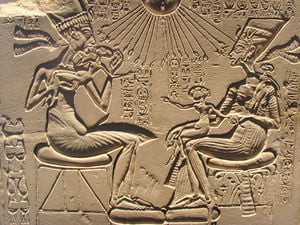All those epic historical movies depicting leaders of nations looking like the classic virile and beefy male might have to be rethought in the annals of history. Even the pharaohs in Ancient Egypt that are supposed to all have the physique of Yul Brynner might have to be looked at in a different way that probably didn’t matter in that era. You can say that in comparison to how it is now when women are from Venus and males are from Pluto when it comes to how they’re expected to look in modern society. If you go by the recent surprising discovery in the mummified remains of the Egyptian pharaoh Akhenaten, it appears that he had a feminine body compared to the classic body frame we expect of the Pharaohs, though maybe not by choice.
There isn’t any doubt that hermaphrodites were common already in Ancient cultures–particularly in Ancient Greece where the term was born. There hasn’t always been proof that some of them were put into positions of power until hearing about the possibility of Akhenaten having female characteristics on his body. Of course, the thought is that he was suffering from something called Marfan syndrome that’s a genetic disorder sometimes causing the mimicked physical appearance of a woman in men. However, this isn’t proven yet and may give us the idea that women in ancient cultures seemed to find men attractive who didn’t fit the ideal of a Hollywood physique.
That makes psychiatrist extraordinaire Carl Jung’s “Anima and Animus” theory in his analytical psychology writings so revolutionary in understanding why this happened in history. Jung, as he did with his archetypes of the collective unconscious, managed to attach historical figures as to why some people subconsciously exhibit female tendencies and females exhibiting male tendencies. Now it might help us understand the roles of leaders in ancient cultures a little better applying Jung’s ideas toward this aspect–if not explaining why androgynous behavior was exhibited prominently then.
With that, we may find out that Akhenaten’s wife, the proven beauty Nefertiti, may have had her own male side without (based on busts anyway) showing any physical signs of masculinity.
How Jung’s Anima and Animus theory applies to historical figures with the archetype of other historical figures…
Most of Jung’s theories for the Anima side of things (the male) revolve around the male’s unconscious desire to tap into higher states of emotion or a better sense of spirituality through four important, evolutionary steps. That’s why Jung based his analogies on famous women in history who, as he insinuates, are really in the soul of every male–no matter how powerful he is.
The first level a male develops as he learns and matures is the Eve level where the man places himself in the understanding that a woman is every man’s desire, but with the tainted thought in our DNA that the woman is powerless and not worthy of living up to the virtue that they originally were expected to be. There isn’t any doubt that ancient cultures already considered women to be lesser than they should have been–with ancient Egypt Pharaohs unusually making their wives almost equal in power with them without being allowed to make a final decision. Tapping in to Eve, though, was a given at that point when it wasn’t all that far away in time.
Next would be the Helen of Troy level where the man subconsciously understands the practicality of women and how they can succeed in business in an intelligent way, with the supposed caveat that the success doesn’t have to be done in a virtuous way. You can see this all over ancient cultures by the male figure…right up to the era of Donald Trump. Don’t tell The Donald, though, that he has a little bit of Helen of Troy (or Trump) in the structure of his mind.
In the third level, the man thinks backwards to the time of Mary where he finally finds the virtuousness in women. The Ancient Greeks and Egyptians seemed to find that, despite not always showing it outwardly, which is part of how Anima and Animus works in men and women. Jung says that all men make it through these levels subconsciously, even if they’ve displayed the notion that they’re stuck on level one. Mostly, they’re just attracted to the women that represent these traits men have deep in their subconscious.
The most important and final level is the one named after Sophia; not a person, but the principles in Ancient Greece representing ultimate wisdom in the balance of being of the world and being virtuous all at the same time. If the Greeks understood this early, then it shows how advanced they were in the advancement of women, if men still dominating in the culture. And, of course, the Greeks had more than their share of gay men who (along with the hermaphrodites) understood the nature of women.
_____
Lest anyone think that there was a domination of the female side of things in running nations, the women in those times also had a tendency toward the male side as Jung said with his opposing Animus in the woman’s subconscious. All four levels involved the athlete, the planner, the professor and the guide that women demonstrate openly a lot more today, but were there in-waiting as the women sat on their thrones next to their husbands.
Nobody really knows for sure that a wife of a leader in ancient times such as Nefertiti didn’t show all four levels to her husband…who ultimately may have looked physically like a woman and demonstrated more characteristics of a woman than we probably know. In the history of famous couples who ruled nations, there may have been role reversal situations all the time behind closed doors.
All we need as proof are those stories of past U.S. Presidents saying how they make decisions based on talking to their wife in bed at night after a long day. We’ll just hold out on hope in our history, however, that some of our Presidents weren’t so much like women that they were having dressing parties with J. Edgar Hoover…





